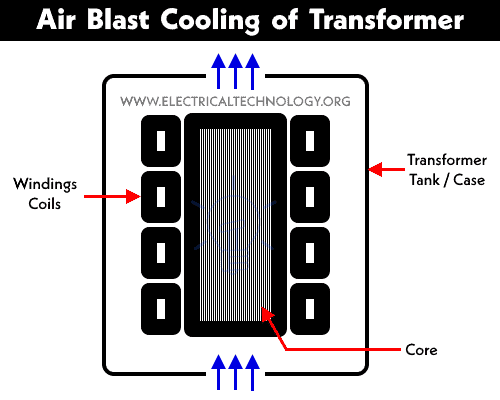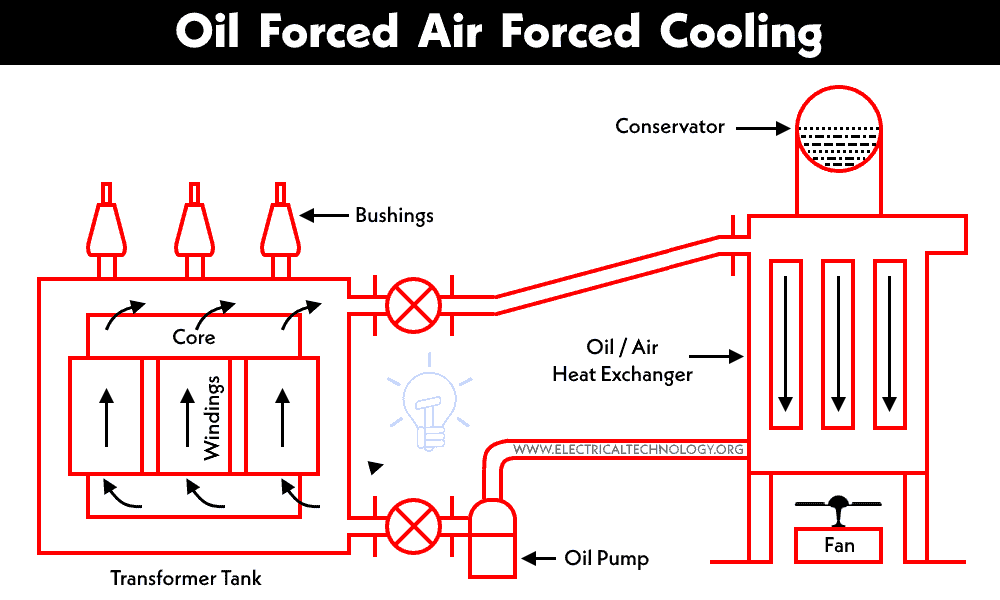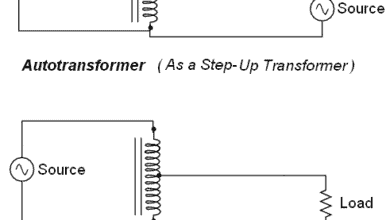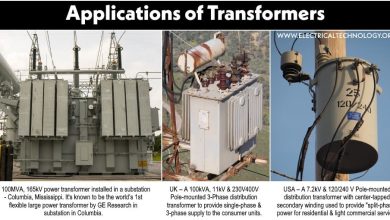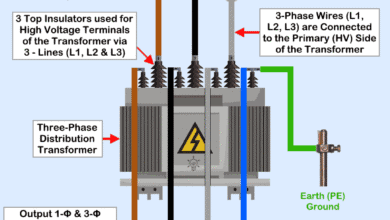Cooling Methods of a Transformer
Types of Cooling Methods of Electrical Transformers
A transformer is a static electromagnetic device that is used to convert electrical energy from one voltage level to another voltage level. During this process, some amount of energy is lost in the winding and core of the transformer.
The energy lost in a transformer is dissipated as heat. The amount of energy that is lost in a transformer is very small compared to the amount of energy is transferred. But it becomes very large for a higher kVA rating. And for a large kVA rating of a transformer, heat dissipation is a difficult task. The temperature of a transformer will rise and it may cause damage to the insulation if the heat dissipation is not done properly. Hence, it is necessary to maintain a temperature within a permissible limit to avoid thermal degradation of insulation.
The method used for the transformer cooling depends on the type, size of a transformer, and suitable conditions at the site where it is installed. The transformers can be dry or oil-immersed type. There are two types of coolants are used in the transformer;
- Air
- Oil (Mineral Oil or Transformer oil)
The transformer that uses air as coolant is known as a dry transformer and the transformer that uses oil as a coolant is known as an oil-immersed transformer.
The methods used for dry transformer is;
- Air Natural Cooling
- Air Blast Cooling
The methods used for oil-immersed transformer is;
- Oil Natural Cooling
- Oil Natural Air Forced Cooling
- Oil Natural Water Forced Cooling
- Oil Forced Air Natural Cooling
- Oil Forced Air Forced Cooling
- Oil Forced Water Forced Cooling
Related Posts:
- Open Circuit and Short Circuit Test of a Transformer
- Sumpner’s Test or Back-To-Back Test on Transformer
Now, we discuss all these methods in brief.
Air Cooling
Air Natural Cooling
For small rating transformers (5 to 10 kVA), the external surface is sufficient to dissipate heat. This type of transformer uses enclosures for air convection and heat released by natural radiation from the case itself. Generally, instrument transformers (except higher voltages) are dry type and use this method for cooling.
Air Blast
This method of cooling is used for the dry transformers. In this method, external fans or blowers are used for a continuous blast of air through the winding and core of a transformer. This method of cooling is used up to the rating of less than 25 kVA and used in a place where oil is considered a fire hazard.
The transformers are placed in a chamber where the air is maintained under pressure by blowers. In this method, pressurized air is forced at the winding and core of the transformer and discharges this air through the top of the chamber. Compared to an oil-immersed method, high-strength insulation is required in this method. A filter is used in this method to avoid dust in the internal part of the transformer.
Related Posts:
Oil Cooling
Oil Natural Cooling
In this method of cooling, the winding and core of a transformer are immersed in the oil. An oil-filled iron tank is used as an enclosure. The heat produced by the core and winding is transferred to the oil by the process of conduction. The oil temperature rises as it comes in contact with heated parts. And the place of heated oil is taken by the cool oil. The heated oil transfers heat to the tank surface and heat dissipates to its surrounding.
The power transformer with a capacity of up to 10 MVA has a cooling radiator system with natural cooling. This method of cooling is the most used method for oil-immersed transformers because of the below advantages;
- Freedom from dust
- Easy heat dissipation from the inner part
- There is no effect of moisture
- The oil has a high coefficient of volume expansion. Hence a good amount of heat is dissipated by natural convection.
For a large rating of transformer, the smooth surface of the transformer tank is not sufficient for proper heat dissipation. In this condition, fins are used to increase heat dissipation area. In many cases, radiators and tubes are provided on the walls of the tank to further increase the heat dissipating capacity.
Related Posts:
Oil Natural Air Forced Cooling
This method of cooling is used for oil-immersed medium to large capacity transformers. In this method, cooling is improved by forcing air to the cooling surface. The air is forced to the external surfaces (like radiator, tank, tubes, etc.) with the help of fans.
Oil Natural Water Forced Cooling
In this method, the winding and core are immersed in oil. And the water circulates through copper cooling coils to increase heat dissipation. The coils are mounted above the core and inside the oil surface. The heat is transferred to the water and heated water is cooled in a spray pond or cooling tower. This method is more suitable where a nature water head is available.
Oil Forced Air Natural Cooling
This method is rarely used. In this method, a pump is used to circulate the oil. And heated oil is cooled in a heat exchanger by the natural circulation of air. This method is useful where the coolers have to be removed from the transformer.
Related Posts:
- Advantages of Three Phase Transformer over Single Phase Transformer.
- Difference Between Power Transformers and Distribution Transformers?
Oil Forced Air Forced Cooling
In this method of cooling, the oil is circulated in the transformer with the help of a pump. The heated oil is cooled in an external heat exchanger. For more cooling, the air is a blast with the help of a fan. Generally, in this method, temperature sensors are used.
During light load condition, the losses that occur in a transformer is small, and very less amount of heat is generated. In this condition, the fan or pump may be switched off, and if the temperature increases, the pump, and fan switched on. This method results in higher efficiency for the entire system and it is used for power transformers that have a rating of 30 MVA or more.
Oil Forced Water Forced Cooling
In this method, the heated oil is carried out from the main tank and transferred to the heat exchanger with the help of a pump. In a heat exchanger, the oil is cooled by the water passing through the copper tubes. The oil pressure is kept higher than water pressure to avoid any leakage that occurs from oil to water. This type of cooling system is suitable for the hydroelectric power plant.
Related Posts:
- Applications of Transformers
- What is an Ideal Transformer?
- Parallel Operation of Single-Phase & Three-Phase Transformers
- Transformer’s Losses- Types of Energy Losses in a Transformer
- What is the Transformer’s Voltage Regulation?
- Transformer Efficiency, All day Efficiency & Condition for Maximum Efficiency
- The Dot Convention and Dot Notation in a Transformer Phasing
- Transformer Performance & Electrical Parameters
- Power Transformer Protection and Faults
- Transformers Fire Protection System – Causes, Types & Requirements
- Can We Replace a 110/220 Turns Transformer with 10/20 Turns?
- Electrical Transformer Symbols – Single Line Transformer Symbols
- Can We Operate a 60Hz Transformer on 50Hz Supply Source and Vice Versa?
- Which Transformer is More Efficient When Operates on 50Hz or 60Hz?
- Transformers (MCQs With Explanatory Answers)
